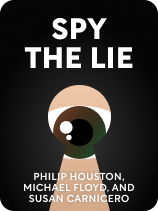

This article is an excerpt from the Shortform book guide to "Spy the Lie" by Philip Houston, Michael Floyd, and Susan Carnicero. Shortform has the world's best summaries and analyses of books you should be reading.
Like this article? Sign up for a free trial here.
How do you know when someone is lying to you? Is there a guaranteed way to know?
To tell when someone is lying, note how they respond within the first five seconds of asking them a question. Using this and other strategies can help you determine what is true and what isn’t.
Continue reading for more on how this system works and what the best way is to tell if someone is lying.
Why You Need a System to Detect Deception
How do you know when someone is lying? Former CIA professional and author of Spy the Lie Philip Houson recommends a specific system. You might wonder why you need a system to detect deception—like most people, you likely feel that you can tell when someone’s lying to you. However, it’s impossible for anyone—even intelligence community professionals—to simply know whether someone is lying. There are two reasons for this: human bias and people’s tendency to hide deception within truth.
Reason #1: Humans Are Biased Toward Believing Others
Even when you have good reason to think someone is lying to you, your inherent desire to believe them can make you miss or excuse signals of their deception. You may even be biased to believe certain kinds of people are trustworthy—a Supreme Court justice, your grandmother, or the manager of your child’s daycare—although people from all walks of life can be liars.
(Shortform note: Why do we have a tendency to believe others, if it doesn’t always help us? In The Liar in Your Life, psychologist Robert Feldman explains that your brain is hard-wired to assume others are honest. This served an evolutionary purpose: Someone who’s not constantly wondering whether others are trying to deceive them can allocate their mental energy to other tasks more important to survival.)
Reason #2: People Often Hide Deception Within Truth
When it comes to spotting deception, many people think they should look for fabrications: false statements, which can be easy to notice because they conflict with known facts. In reality, deception often hides within truth—instead of making direct fabrications, a deceiver will carefully speak in a way that adds no new information to a conversation, and therefore can’t obviously conflict with the truth. This makes their deception more difficult to notice. (Shortform note: Studies underscore this point on the difficulty of detecting deception—most people do a poor job of it because they’re focused on the question of whether someone is lying rather than looking for subtle signs of insincerity.)
The Basics of the System
In his CIA career, Houston interviewed people using a polygraph machine, a device that charts a person’s physiological responses to questions. As Houston gradually learned which verbal and behavioral signals reliably linked to deceptive responses, he created a System to replicate the polygraph’s functionality in two steps:
- Ask someone (we’ll call him the “interviewee”) a question. This stimulus prompts the interviewee’s verbal response and involuntary physical reactions.
- Watch and listen closely to your interviewee’s reactions and responses. You’ll look for elements of their response that suggest they might be deceiving you or having a physiological reaction to your question. (We’ll cover telltale verbal and behavioral signs of deception in the final section of the guide.)
The Key to the System’s Success: The Five-Second Rule
The authors stress that human brains simply cannot process and analyze each word and behavior in a conversation. The System gets around this shortcoming by implementing the five-second rule: Instead of trying to interpret the meaning of everything the interviewee says or does, you’ll watch and listen for signals of deception only in the first five seconds following each question.
This rule has two main benefits: First, closely observing the period immediately following your question tells you whether your interviewee’s actions are direct reactions to what you asked. In other words, if you see a sign of deception within five seconds of asking your question, you can assume your question triggered it. However, if you see a potentially suspicious sign outside of this timeframe, you can likely disregard it.
(Shortform note: While this system focuses on the deception-spotting advantages of constricting your observations to five seconds, it’s worth noting that doing so can also help ensure your interviewee’s accuracy. Research suggests that short-term memory starts to introduce inaccuracies after only a few moments. In other words, with each passing second, your interviewee remembers your question less accurately, increasing the chance that they respond to a distorted memory of your question.)
The System’s second benefit is that it allows you to catch both verbal and behavioral signs of deception. Your brain’s wired to focus on either auditory or visual information—but with intense focus, you can listen to and watch an interviewee at the same time. However, the type of intense focus required for this takes enormous effort that you can only keep up for a short time. Your burst of intense focus is most effective in paying attention only to those signs that show up in the five seconds following your question—as they’re most likely to be signs of deception related to your question.
| Why Simultaneous Audio and Visual Processing Is So Mentally Taxing Why does it take such intense focus to both watch and listen to an interviewee? You process both auditory and visual information in the same part of the brain. Studies suggest that when your brain receives simultaneous audio and visual input, it automatically prioritizes the audio and alters your visual perception to match the brain’s expectations. For example, if you hear a raccoon chattering outside but see a cat, your brain will alter your perception of the cat to be more raccoon-like. This audiovisual association happens automatically, and it takes a good deal of mental energy to actively work against it—for example, in situations where your interviewee may claim their innocence while their body language conveys guilt. Additionally, some research suggests that listening to audio details reduces your ability to concentrate on visual details, and vice versa—and trying to pay attention to both at once reduces your ability to focus on either. |
Watch for Clusters
Once you notice a sign of deception within those crucial five seconds, pay attention to whether it forms a cluster. A cluster is when the interviewee shows two or more signs of deception in their response. The first sign must happen within the first five seconds following your question, and the further signs of deception can happen at any time in the response, up until the interviewee is interrupted by another stimulus. (Shortform note: Though the authors don’t define what “interruption” means, we can infer that it refers to any event, including another question, that draws the interviewee’s attention away from you.)
If you notice a cluster, you can be confident the interviewee tried to deceive you in their response to your question. You can then continue asking questions with this knowledge in mind.
(Shortform note: The authors’ usage of the term “cluster” is generally consistent with how other deception detection experts use it. However, experts disagree slightly about the minimum number of signs needed for cluster formation—while some, like the authors, consider two signs the right number, others say a cluster has a minimum of three signs.)

———End of Preview———
Like what you just read? Read the rest of the world's best book summary and analysis of Philip Houston, Michael Floyd, and Susan Carnicero's "Spy the Lie" at Shortform.
Here's what you'll find in our full Spy the Lie summary:
- Why your brain is wired to believe others
- How you can learn to read body language like a spy
- The three traits of effective lie-detecting questions






